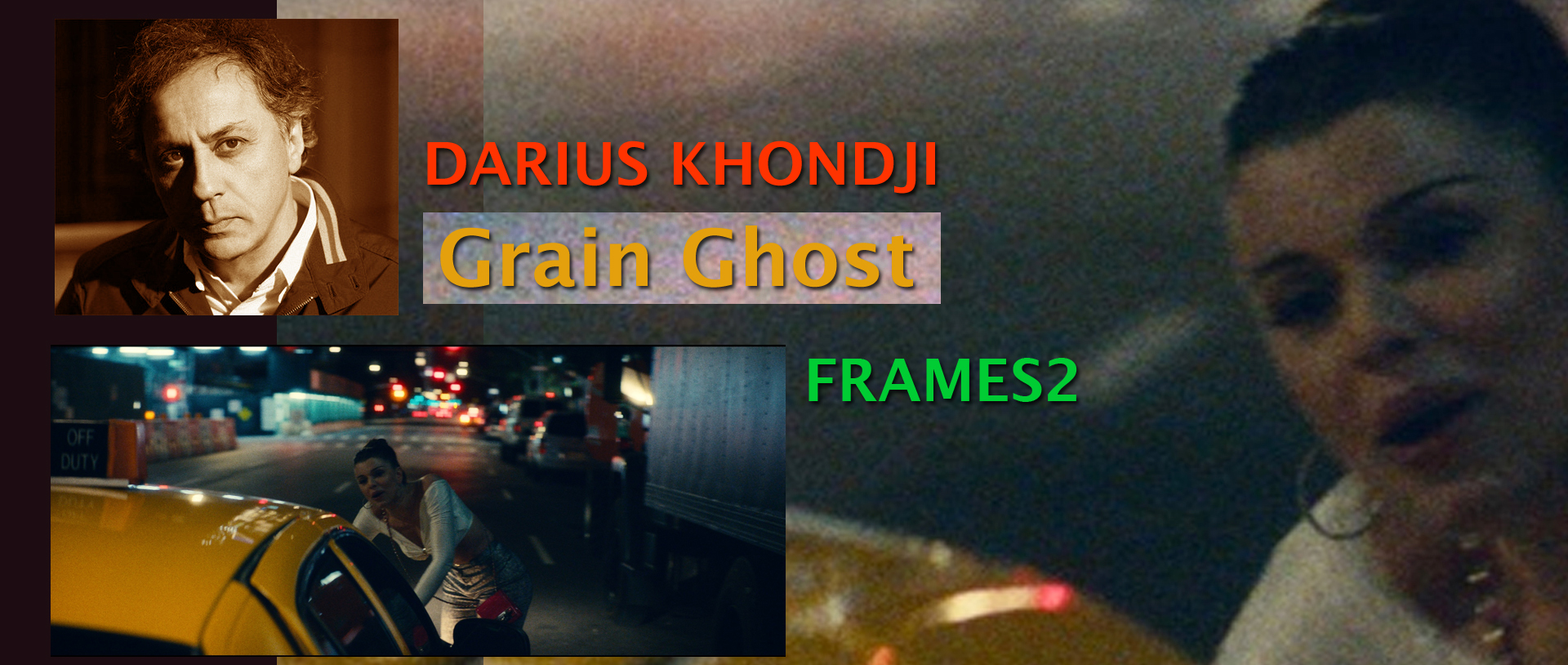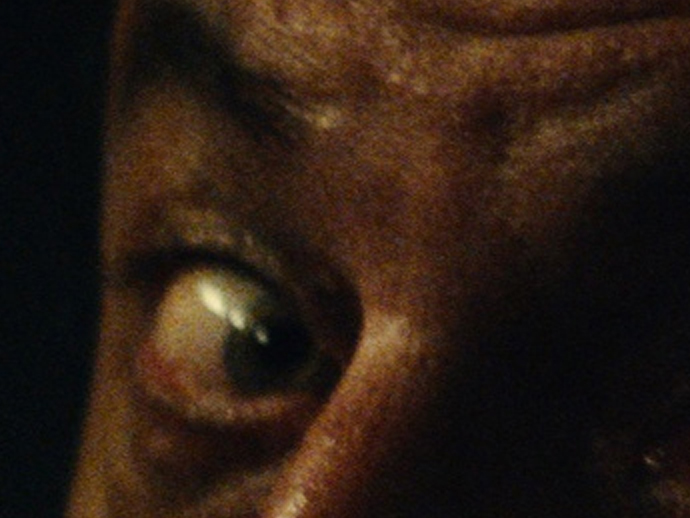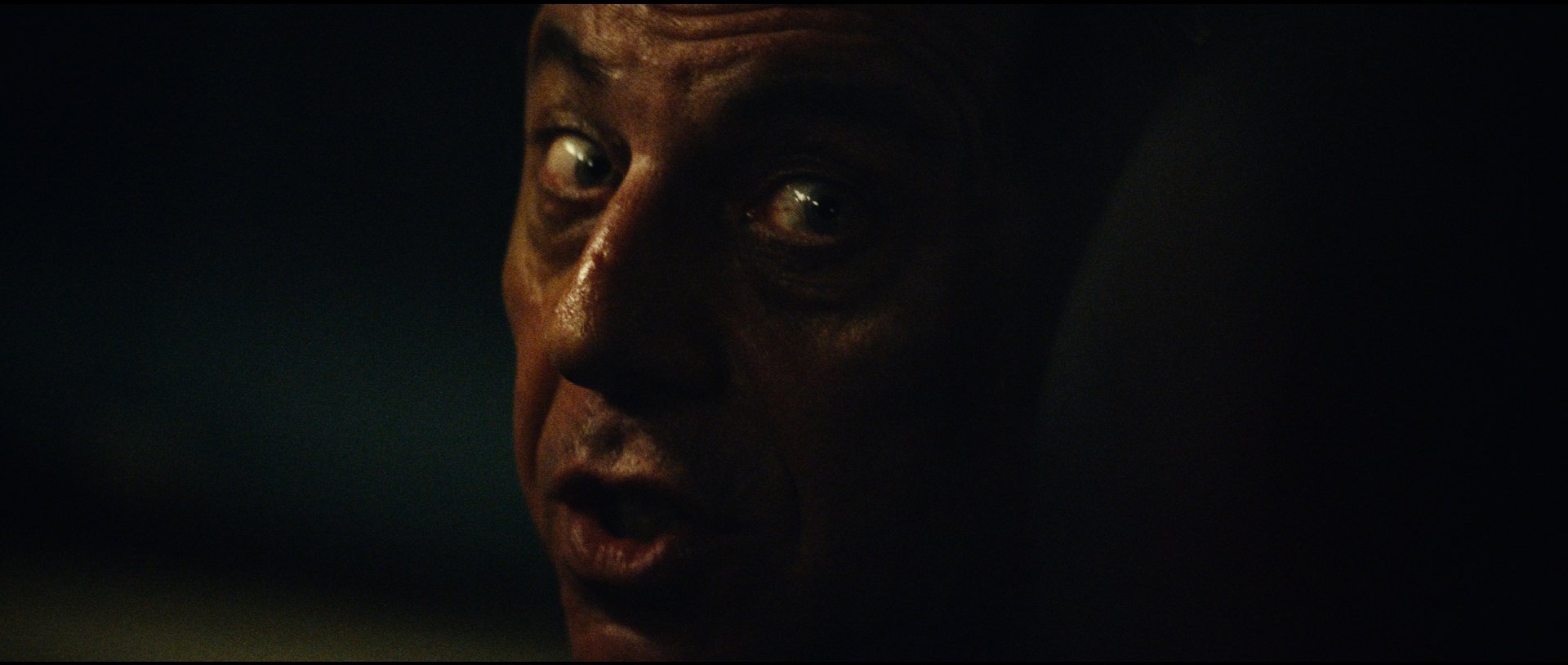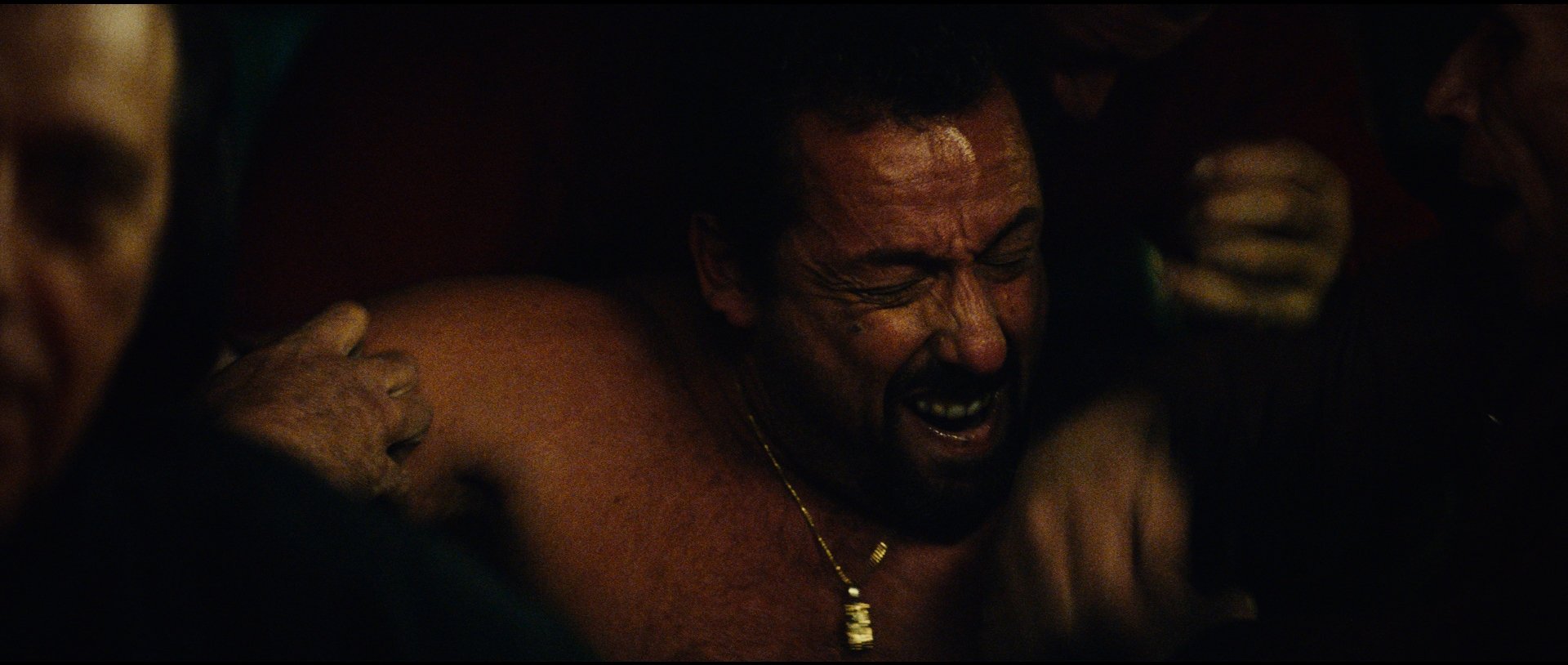
Grain Ghost -- Frames2 -- Uncut Gems with Darius Khondji, ASC, AFC
Frames2 offers a detailed look at Darius Khondji's lighting for the nights of Uncut Gems, the application of film grain to the Alexa image, and underexposure.
This is the second FRAMES post, about Uncut Gems by the Safdie brothers with cinematography by Darius Khondji, ASC, AFC. The idea of the FRAMES series is to present the highest quality frame grabs along with discussions with some of the filmmakers. In addition to Darius, I include comments here by gaffer Andy Day and colorist Damien Van Der Cruyssen.
A persistent theme in my discussions with Darius about Uncut Gems is the idea that background visual elements bring emotion and content to the scene, even when they aren't consciously noticed by the audience. I associate this notion of the importance of background with media philosopher Marshall McLuhan.
FRAMES1 discussed bokeh as an example of a powerful background element. This post presents Darius' approach to the night interiors and exteriors, and underexposure, with grain as a key background element.
+++
1. Uncut Gems
2. Night Rules
3. Location Lighting List
4. Night Interior - Passover
5. Adding Grain
6. Studying Grain
7. Night Exterior - Taxi
8. Grain Ghost
9. Night Exterior - Suburb
10. Underexposure - Grainy Goya
LINKS
+++
1. Uncut Gems
If you watch the trailer below, you may want to focus on the nights and the background grain, the subjects of this post.
Trailer for Uncut Gems - watch on YouTube
Uncut Gems is a powerful film by Josh and Benny Safdie that follows Howard Ratner, a fast-talking jewel salesman in Manhattan's Diamond District, as he seeks to make money with a rare gem, while evading dangerous loan sharks. Compellingly played by Adam Sandler, Howard is a charismatic but deeply flawed character, a compulsive gambler willing to risk everything to strike it rich. The Safdie brothers' fifth feature is a funny, whirlwind thriller that keeps you on the edge of your seat. Darius Khondji's cinematography imprints the film with potent imagery that is rooted in gritty realism with painterly touches. If you haven't already, I urge you to watch Uncut Gems on Netflix.
+++
2. Night Rules
Darius and the filmmakers made 3 key aesthetic decisions for the night scenes in Uncut Gems:
1. All the night scenes were shot with an Alexa Mini at ISO 1600
-- All the daytime scenes -- including the scenes in the windowless Showroom set -- were shot with Arricams and 5219 negative film. Darius pushed most of the negative one stop to bring out the grain.
2. All the night scenes were shot on location
-- Darius adapted his lighting of night scenes to existing urban lighting, bringing city light sources into the frame, through an apartment or car window, or as a background when shooting outside.
-- Matching the exposure for urban lighting meant working at a low light level, often with LED fixtures.
-- The choice of 1600 ISO ( 1 stop faster than Arri's recommended 800 ISO) made it easier to reveal the New York nighscapest, but also accentuated the digital sensor noise.
3. Film grain was added to the night footage in the DI.
-- Darius chose to add grain to the grain-less Alexa footage. This helped to unify the daytime and nighttime footage, shot in negative and digial. The added grain also subtly transformed the background of the night scenes.
-- In collaboration with colorist Damien Van Der Cruyssen, Darius opted to add grain from exposed 5219 to the Alexa, creating a unique hybrid texture that combines underexposed sensor noise with the grain of actual film negative.
+++

+++
3. Location Lighting List
All the night scenes in Uncut Gems were shot on location, which contributes to the film's realistic feel. Gaffer Andy Day was kind enough to share the location lighting list:

I am struck by the mix of classical and contemporary tools in Darius' lighting:
-- The Tungsten quartz sources include traditional hard lights with Fresnel lenses, going from 150 watt to 12K, along with Mini Brutes and the precise Source 4. The soft Tungstens include Rifalites and old-school Ziplights.
-- The HMIs feature big Arri fixtures, complemented by Jokers from K5600 Lighting. Soft lighting is provided by Chimera Chinese Lanterns, Pancakes and Octaplus'.
-- There is also a range of Kinoflo banks.
-- The LED sources include Arri Skypanels, Digital Sputniks, Litegear Litemat Plus panels and units from Cineo.
-- Digital Sputnick DS6 units were added in for big night exteriors
--
As discussed in FRAMES1, Darius made frequent use of battery-operated Astera Titan LED tubes, with additional units brought in as needed.
+++
4. Night Interior - Passover
Benjamin B: Most of the film is shot with 35mm negative, why did you decide to shoot the nights with the Alexa?
Darius Khondji: It started with the Passover dinner scene. The location was a New York apartment which had a great view of the city. At first they thought of shooting it during the day with blacked-out windows, but I said: "Let's do it at night with the city in the background". And that’s how I began going to the Alexa, because I knew we'd be able to see the city easily. I wanted to give the directors as much freedom as possible, and the Alexa gave us more freedom to shoot nights.
BB: So you set your exposure to the city background?
DK: Exactly, with the Alexa Mini at 1600 ISO. The lighting inside comes from a pancake above the table ... and also the candles. I used a Black Pro Mist filter.
+++
Andy Day (gaffer): We created a soft flat source above the table with Astera tubes; we modified the color temperature with DMX to make it work with the candlelight. Being able to tweak the color of the LED sources is really important for Darius.
Benjamin B: LEDs seemed to play a key role in the lighting on this film
AD: Yes. We had Tungsten and HMI on the list, but it was so much more about the LED color options. Those were very exciting for Darius, and for me too! He is so fond of being able to go outside of CCT [Correlated Color Temperature], and to work instead with RGB [Red Green and Blue].
BB: How was it working with Darius?
AD: Darius is an incredibly experienced, working legend. He is a wonderful guy, and a passionate artist.
+++
5. Adding Grain
Benjamin B: The Alexa night footage feels very film-like.
Darius Khondji: We added grain to the digital footage to match the film footage. At first we tried adding digital grain, but it wasn't as nice as the actual film grain. So Damien, my colorist, suggested adding real film grain to the digital footage, and that worked.
+++
Benjamin B: Damien, where did you color time Uncut Gems?
Damien Van Der Cruyssen (colorist): I prepared the LUTs with Darius before the shoot, and also timed the dailies and the final DI at The Mill in New York, using a Baselight from Filmlight.
Our biggest challenge was making film and digital look similar. We did a lot of tests with Darius. We tested the Alexa at different ISOs, and it started to feel like a good match to film at 1600. For the dailies we used the Baselight grain plug-in, which is quite good, but for the final DI we wanted to have the same grain on digital and on film.
BB: In your DI experience, do a lot filmmakers want to add grain?
DVC: Most movies shooting digitally want to add grain. In fact, there’s only one digital feature I've graded that didn’t add grain.
BB: How did you get the film grain footage that you added to Uncut Gems?
DVC: I asked the crew to shoot film on a dark gray background. We pushed that negative, like the rest of the film footage. We had 30-second samples at pushed 2 stops, pushed 1 stop and normal. Most of the grain we used was pushed 1 stop. I created a loop with two minutes of grain to add to the Alexa footage.
BB: How did you add grain to the signal in DI?
DVC: I put it at 50% gray, so it maps mostly to the mid-tones and the blacks. I overlayed the black and white grain over the colored image. It took a while to really get it right
BB: So all the color of the grain comes from the image, not the grain?
DVC: Yes, the grain is a black and white image, but I can also tint this grain overlay. On some scenes I made the shadows a little cooler. We varied the grain to match the image. I can push that slider and adjust the amount of grain. Sometimes I pushed the contrast of the grain also. We didn’t want it to feel like the same grain overlaid throughout the movie, each scene has its little differences.
BB: There seems to be less grain in the highlights
DVC: I could control it, so as to have a little less grain in the highlights and a little more in the shadows. I tended to have it roll-off in the highlights because I feel it’s less distracting. Having grain on a highlight feels very strong. If you look at a film print, you rarely see the grain in the highlights.
BB: That makes sense, and I did feel the grain more in the dark Alexa nights than in the daytime scenes shot on film.
DVC: Darius did feel that some of the daytime footage shot on film didn't have enough grain.
BB: Did you guys ever consider also adding more film grain to the film footage ?
DVC: We did think about it... But we resisted that temptation! [laughter]
+++
6. Studying Grain

Film grain is a background that is not usually noticed by audiences because it's made of small elements, and because it changes from frame to frame. Grain's mobility and texture give life and visual complexity to the footage. I believe that grain's continuous subtle modulation of the background draws you into the image and keeps you engaged.
The still frame DETAILS in this post don't show the whole story: they reveal the spatial aspect of grain, but not its temporal quality. The full impact of grain is best appreciated by watching the trailer above, or, even better, the Netflix movie on your largest screen.
Yet I hope these magnified DETAILS will help you explore the power, color and intricacy of the hybrid grain created for the night scenes in Uncut Gems, and allow you to study the individual grain elements, their clusters, their varying colors, their patterns and sizes. The idea is to move the grain background into the foreground.
+++
7. Night Exterior - Taxi
Benjamin B: I love the stark quality of the New York night exterior, when the lovers, played by Sandler and Julia Fox, quarrel next to the taxi outside the nightclub. How did you guys light this?
Andy Day (gaffer): Darius is very fond of interplay with the real environment
of the city at night. So we worked at a light level that allowed us to hold the city in the background.
We hung our lights on existing structures. We turned off some street lights to control light direction. We hung a Skypanel with a Chimera on a lamp post to create a big pool of light, and some Sputniks off of fire escapes.
BB: You can see two of those sources reflected in the taxi window... I like that strong three-quarter backlight from the right, simulating headlights.
+++
Benjamin B: Here again, Darius, you're setting the lighting to match the city background.
Darius Khondji: Yes, I need very little light in digital. We shot this scene without a permit.
BB: I love the city background. It looks like the frame above was shot with a zoom, because of the rectangular bokeh, which is often a sign of a rear anamorph.
DK: It was a Panavision zoom that Dan Sasaki kindly prepared for me.
+++

+++
Benjamin B: The grain is very powerful in this image
Damien Van Der Cruyssen (colorist): Darius and the Safdies wanted a bolder look than in other scenes. I strengthened the grain to play with the emotions of the couple's fight. And I added contrast to the grain. They liked the roughness of this image.
I also added a little blue in the darker bits of the grain.
It affects the whole image, but it’s more like a little offset between the white part and the shadow of the grain. The darker parts are a little cooler than the brighter parts.
With film if you underexpose and brighten back, it will lift the blue channel.
Here we increased the grain, so that it feels like it’s been pushed two stops instead of one stop, and then also add a slight blue bias, as if it was underexposed and we brightened it as much as we could, but just got blue noise.
BB: So you’re simulating film underexposure here?
DVC: Yes
BB: The grainy, harsh image really works with the argument between the characters. When you zoom into the image, it looks like a Seurat painting. There's a swarm of colors: blue, red, green, violet, pink...
DVC: The mix of colors is gorgeous. It's the city lights captured by the Alexa at 1600 ISO.
+++
8. Grain Ghost
Benjamin B: When I saw Uncut Gems projected at Camerimage, I didn't feel the difference in texture between film and digital. Of course, the grain and the anamorphic helps.
Darius Khondji: Yes. I counted a lot on anamorphic and grain to blend film and digital. And also pushing the Alexa sensor.
BB: The grain is so very present, so very strong throughout the film.
DK: Remember that I pushed the film negative one or two stops to bring out the natural grain. At the same time, I push 2 stops but I only expose for 1 stop, so I clean up the negative before I put it in the bath where I add 2 stops. I augment the contrast and the grain, so that the grain exists but it’s not too noisy.
BB: We've spoken about this before. You often do this kind of thing, applying two opposite processes at once, like pushing and over-exposing.
DK: That's true. Another problem here is that sometimes with digital the blacks are very gentle, very soft.
BB: We previously spoke about the bokeh as the invisible background of the image, you compared it to a "perfume". It strikes me that the grain is like the bokeh, it's also in the background and it also brings a lot of emotion to the image, even if you don't notice it.
If the bokeh is the personality of the lens, then maybe the grain is the personality of the negative. But it's strange that you can add that personality to your digital images. It's like putting the ghost of the negative into the Alexa images.
DK: Yes! A grain ghost...
+++
9. Night Exterior - Suburb
Benjamin B: The scene in the parking lot outside the suburban high school is a gentler night exterior than the city. The frames here show Howard Ratner, played by Adam Sandler, and his wife, played by Idina Menzel.
Andy Day (gaffer): We had two Skypanel S 360-Cs on a lift.You see their light on Adam's back. We drove the 360s to the other side of the parking lot for the shot on Idina.
The two 360s on a lift become a large source, almost like a couple of Maxi Brutes going through a 4x8 frame of Magic Cloth. We had Skypanels on the roof, enhancing the streetlamps. In addition we had some sources doing architectural lighting, creating light and dark zones. We colored them easily via DMX.
The sharp light that Adam’s walking towards is a DS6 on a lamppost. Darius had used the Sputniks before. They’re very punchy, and lightweight so it's very easy to hang them on lampposts, and they're very controllable.
+++
Darius Khondji: Everything was done with LEDs. I had lights up on the roofs very high, and lights hanging on the streetlights. I changed the colors of the LEDs to match the mercury-vapor streetlights in the parking lot. The nights in this film have sources that are very mercury-vapor, this blue with some dirty green. I love to add green to nights.

Benjamin B: The color is complex, there's blue with a cyan feel to it, and even some violet.
DK: In fact, I always told my gaffer Andy and my colorist Damien that I wanted the nights to look silvery. It’s not blue, it’s metallic.
BB: I love the zones of light in the background of these images.
DK: I lit as little as possible so as to have a lot of black in the image. I like that it’s like blades of light in the darkness.

+++
Damien Van Der Cruyssen (colorist): This scene was a challenge, we spent time finding the right balance between Darius' silvery night and the rich pop colors that the Safdies like. So we wanted the blue night mixed with that green grass and the warmer tones from the building lights. The grain helps because it adds life to it. The buzz of the grain makes the mix of blue, cyan and green richer. You can see, however that there is no grain in the highlights.
Benjamin B: The tradition is to have nights blue, this feels more like a cyan night.
DVC: Yes, in the midtones and highlights it feels cyan, but it gets bluer in the deep shadows. So we create color contrast by twisting from green to blue as we go from highlights to shadows, and we also boosted the green grass.
BB: I love the color of the buildings, they're almost magenta
DVC: The brick building have a light reddish tone, with mix of blue, so it went a little bit magenta.
We wanted to keep a little warmth there, which helps to break away from cyan night. Along with
the yellower windows and the cooler shadows it’s all part of never getting too monochromatic, it's about finding the right balance of colors.
+++
10. Underexposure - Grainy Goya
Benjamin B: I love the scene when the bad guys torment Howard Ratner in the car. I recognize your colors here. It's beautifully underexposed.
Darius Khondji: What you see in this car at night where the faces meld into one another, is a paste made of underexposure. The faces are half-exposed, shot at 1600 ASA. It's digital and we added grain, but they were already buried in charcoal, imprinted by ashes in this gold and bronze-colored paste.

DK: When I first started out, I would underexpose by taste, without thinking about it. Then when I met David Fincher on Seven, he told me that he really liked my underexposures, which he expressed as a technical choice. So we did tests, and explored underexposure. Since then I have used underexposure whenever I could. All the nights in Uncut Gems are underexposed.
I can say that I’m now comfortable with underexposure, but at the same time it scares me, which is normal. Underexposure is a zone in which I go to despite myself, in which I find gold and... gems! It’s in extreme things that one finds beauty.
This makes me think of Goya...
BB: The Black Paintings?
DK: Yes. I'm going to shoot Goya's paintings at the Prado for an upcoming project with artist Philippe Parenno.
+++

BB: This is hybrid grain, the digital noise from the underexposed sensor gets enmeshed in the grain from the pushed negative that is added to it.
DK: Even I forget that it wasn't shot on film
BB: I love the skin, the flesh colors
DK: There's gold, bronze, green
BB: Those are your colors in that strong texture, it's almost ugly, but it's beautiful.
DK: Extreme beauty is always right next to uglyness.
+++

+++++++
A big thank you to Darius Khondji. Thank you also to Damien Van Der Cruyssen, Andrew Day, Chris Silano and A24.
The photo and frames presented are chosen with, and courtesy of, Darius Khondji
+++++++
LINKS
netflix.com: Uncut Gems
wikipedia.org: Uncut Gems
wikipedia.org: Darius Khondji
wikipedia.org: Marshall McLuhan and his concept of figure and ground
imdb.com: gaffer Andy Day
themill.com: colorist Damien Van Der Cruyssen
wikipedia.org: Philippe Parenno
wikipedia.org: The Black Paintings by Francisco Goya
+++
panavision.com: C series anamorphic lenses
kodak.com: Vision3 500T Color Negative Film 5219
arri.com: Alexa Mini
tiffen.com: Black ProMist Filter
astera-led.com: Titan wireless LED tube
arri.com: Skypanel
digitalsputnik.com
Digital Sputnik DS6 manual
+++
thefilmbook: Bokeh Perfume - FRAMES1 - Uncut Gems with Darius Khondji
thefilmbook: Grain Ghost - FRAMES2 - Uncut Gems with Darius Khondji
+++
thefilmbook: Practical Optics 3 - Introduction to Anamorphic
thefilmbook: Visit with Darius Khondji 1. Dimming, Colors, Direction
thefilmbook: Visit with Darius Khondji 2. Sources, Contradictions, Directors
+++++++
+++

















